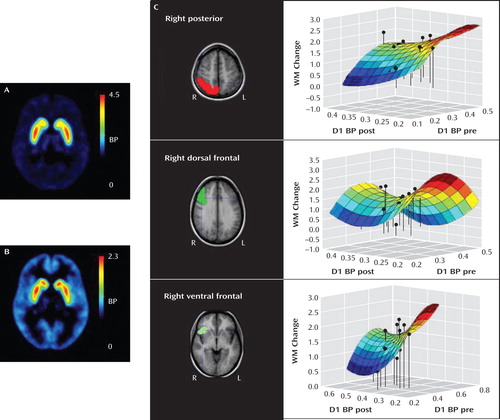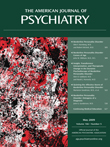Working Memory Remediation and the D1 Receptor
Dopamine receptors from the D2 family are localized in high concentrations in the basal ganglia (panel A), while D1 family receptors , also present in the basal ganglia, are prominent in the prefrontal cortex (panel B). The D1 receptors in the prefrontal cortex have been associated with working memory performance in humans as well as animals and are affected by the release of cortical dopamine during working memory tasks. Working memory is the ability to retain information for short periods of time and underlies many cognitive functions. Moreover, cognitive training on working memory tasks improves working memory in humans, although the molecular mechanisms are not known. The availability of dopamine in the prefrontal cortex affects the movement of D1 dopamine receptors to and from the plasma membrane. However, alterations in dopamine receptors accompanying cognition training have not been identified.

Figure 1. a BP=binding potential; WM=working memory; R=right; L=left.
The images illustrate the results of 13 healthy male volunteers who participated in working memory training for 35 minutes daily for a period of 5 weeks, with task difficulty dynamically adjusted to performance levels. Before and after the working memory training, the following imaging measures were collected for each volunteer: 1) D1 receptor binding potential (BP) using ( 11 C)-SCH23390; 2) D2 receptor BP using ( 11 C)-raclopride; and 3) a functional magnetic resonance imaging blood-oxygen-level-dependent experiment with a working memory task to identify the brain regions active in mediating working memory. Five cortical regions were activated in mediating working memory (the three right-sided regions shown in panel C). Working memory training did not affect D2 dopamine BP in the basal ganglia. However, the D1 dopamine receptor in the prefrontal cortex showed a relationship to working memory training. In general, within the measured range, the increases in working memory after training showed an inverse relationship to D1 dopamine receptor BP in the regions involved in working memory performance. However, the relationship between working memory improvement and D1 BP was not simple. The quadratic model (working memory=α+β 1 BP+β 2 BP 2 ) accounted for more variance than a linear model, supporting this as the best description of the relationship between working memory improvement and D1 receptor BP. Panel C illustrates this complex relationship between the practice-induced working memory change and the cortical D1 receptor BP change in right-sided brain regions (similar changes occurred bilaterally). The present study shows that practice-induced changes in working memory correlate with changes in a predicted molecular target: the D1 receptor BP. The generally inverse correlation may result from the effect of released dopamine on the D1 receptor in the prefrontal cortex or an effect of dopamine on another neurotransmitter, such as glutamate. At the least, this change demonstrates the high level of plasticity of the D1 receptor in response to mental activity in the human brain.



